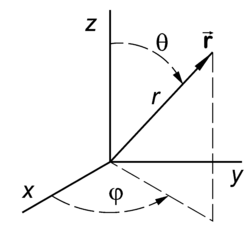Spherical polar coordinates
In mathematics and physics, spherical polar coordinates form a coordinate system for the three-dimensional real space .
Let x, y, z be Cartesian coordinates of a vector in , that is,
where are unit vectors along the x, y, and z axis, respectively. These axes are orthogonal and so are the unit vectors along them.
The length r of the vector is one of the three numbers necessary to give the position of the vector in three-dimensional space. By applying the theorem of Pythagoras twice it follows that r2 = x2 + y2 + z2.
Let θ be the colatitude angle (see the figure) of the vector . In the usual geographic coordinate system used to describe a position on Earth the corresponding latitute angle has its zero at the equator, while the colatitude angle, introduced here, has its zero at the "North Pole", that is, the angle θ is zero when is along the positive z-axis. The sum of latitude and colatitude angle of a point is 900, which explains the name of the latter.
The angle φ gives the angle with the x-axis of the projection of on the x-y plane. The angle φ is the longitude angle (also known as the azimuthal angle).
Note that the projection has length rsinθ. The length of the projection of the latter vector on the x and y axis is therefore rsinθcosφ and rsinθsinφ, respectively. In summary, the spherical polar coordinates r, θ, and φ of are related to its Cartesian coordinates by
Given a spherical polar triplet (r, θ, φ) the corresponding Cartesian coordinates are readily obtained by application of these defining equations.
The computation of spherical polar coordinates from a given triplet of Cartesian coordinates is somewhat more difficult due to the fact that the spherical polar coordinate system has singularities, also known as points of indeterminacy. The first such point is immediately clear: if r = 0, we have a zero vector (a point in the origin). Then θ and φ are undetermined, that is to say, any value for these two parameters will give the correct answer x = y = z = 0. Compare this to the case that one of the Cartesian coordinates is zero, say x = 0, then the other two coordinates are still determined (they fix a point in the yz-plane).
Two other points of indeterminacy are the "North" and the "South Pole", θ = 00 and θ = 1800, respectively (while r ≠ 0). On both poles the longitudinal angle φ is undetermined.
So, when going from Cartesian coordinates to spherical polar coordinates, one has to watch for the singularities.
(To be continued)






